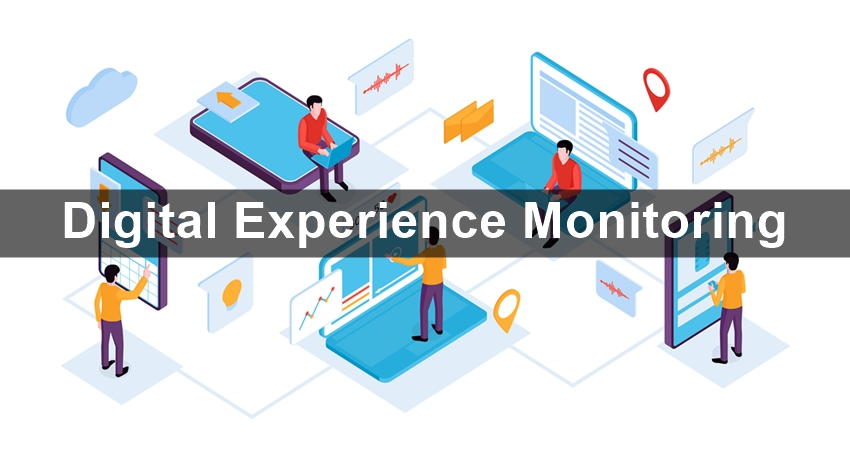If one piece of technological infrastructure is more critical now than ever, it is Digital Experience Monitoring. Digital experience monitoring tools enable the viewing of application performance issues through the user experience perspective, the isolation of service quality issues across the logistics process, the acceleration of root cause determination and resolution, and the optimization of virtual transactions.
What Is Digital Experience Monitoring (DEM)?
DEM is a new technology that businesses are considering to reduce user performance concerns while gaining insight into a range of networking technologies through a single solution.
According to Gartner, “Using DEM, organizations may better train, experience, and execute digital agents, whether they are humans or machines.”
Digital Experience Monitoring is a means of evaluating how well information technology allows end users’ productivity. This provides IT with a better understanding of how devices, applications, and services operate for users and ideas into how to improve the entire digital experience.
Why Do You Need a Monitoring Strategy for Your Digital Experience?
Your cloud application server may appear to be flawless from an IT standpoint, but the end-user may describe it as “glitchy” and “unreliable.” Even though the technical difficulties are not your responsibility, they affect the user’s opinion of your organization and brand.
Issues might arise due to the user’s device restrictions, the browser version, or a regional public cloud outage. Many of these factors are outside your control, but there is no way to prove it without solid evidence that the situation is beyond your control.
According to Statista, Investment in Digital Transformation (DX) is expected to reach 1.78 trillion dollars in the United States by 2022. As digitalization and the Internet of Things (IoT) transforming our interactions with the world around us, it’s sometimes forgotten that wherever connection goes, monitoring must follow closely after.
With the migration of apps and services to the cloud, IT loses control and visibility over all components. This creates a barrier to delivering a high degree of service quality. The public expects internet tools and communication channels to work smoothly at all times.
To deliver on this high-quality user experience, visibility into all accessible channels and control over them through a single portal is crucial. That is why every business’s success needs to have a Digital Experience Monitoring (DEM) plan.
Benefits of DEM for your Business
DEM enables organizations to obtain valuable insights into the customer experience and the digital impact in general.
Active Experience Monitoring Tool
While APM technologies can give valuable insights, they cannot provide the real-time, active end-user experience monitoring that DEM can. APM and related technologies are rapidly becoming obsolete. DEM technologies can help businesses gain a competitive edge by providing direct and real-time insights into the consumer experience.
DEM does this in part through the use of Synthetic Transaction Monitoring. It entails the creation of scripts that are scheduled to execute periodically and imitate user actions to determine if users can still do those activities correctly.
Adapting to Decentralization
Offices, enterprises, and consumers have gotten more decentralized in recent years, most notably with COVID-19. Employees are increasingly working from home, and consumers may now access experiences almost everywhere, including their homes, hotels, shared workspaces, coffee shops, and while commuting.
DEM provides a framework for aggregating and evaluating all user experiences, regardless of whether the user is an employee attempting to log into their email on their phone or a customer trying to purchase an item on their tablet.
Address Dependencies in the Service Chain
The number of dependencies in the service chain has risen substantially – gadgets rely on services and internet connections. A user’s ability to access a web application may also be contingent on the cloud or infrastructure upon which the program is built.
Sure of such dependencies are beyond the control of any IT staff. There are now points in the supply chain that are invisible to IT, limiting the IT team’s capacity to properly understand and manage downtime, outages, page load difficulties, and other issues.
DEM can assist in determining if issues are caused by the end-user device, Wi-Fi, internet service, or an external service provider.
Take into Account Non-Human Users
Another area where DEM might help is with the reality that users can be humans or robots. Because of the Internet of Things, tools and endpoints may also be service consumers.
DEM ensures that you account for these non-human users, ensuring that their use of your service or corporate application is seamless and achieves the desired result.
Data Aggregation
A digital experience framework with many functionalities is commonly used by companies that already have an established DEM strategy. While digital experience administration is complicated, tracking the employee and customer journeys from front to back may be extremely useful.
By utilizing DEM to manage these numerous data channels via digital asset management, the firm will get additional discoverable data and a holistic view of the customer experience, allowing it to improve its digital experience.
As a result, we can infer that Digital Experience Monitoring provides organizations with actionable information into performance issues before negatively impacting the user and tarnishing the brand’s reputation.
